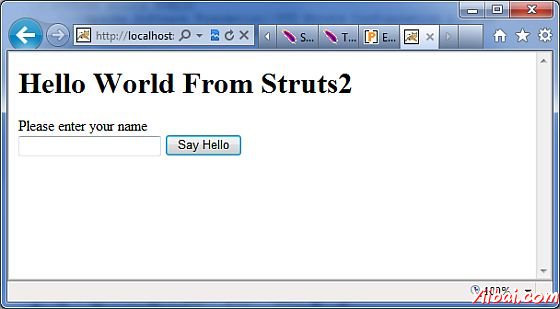Struts2 值棧/OGNL
值棧:
值棧是一個集合中的幾個物件保持下列物件提供的順序:
| SN | 物件& 描述 |
|---|---|
| 1 |
Temporary Objects There are various temporary objects which are created during execution of a page. For example the current iteration value for a collection being looped over in a JSP tag. |
| 2 |
The Model Object If you are using model objects in your struts application, the current model object is placed before the action on the value stack |
| 3 |
The Action Object This will be the current action object which is being executed. |
| 4 |
Named Objects These objects include #application, #session, #request, #attr and #parameters and refer to the corresponding servlet scopes |
值棧可以通過JSP,Velocity或者Freemarker的標籤。有各種不同的標籤在單獨的章節中,我們將學習,用於獲取和設定Struts 2.0 的值棧。 ValueStack的物件裡面可以得到動作如下:
ActionContext.getContext().getValueStack()
一旦擁有了值物件,就可以用下面的方法來操縱該物件:
| SN | ValueStack的方法及說明 |
|---|---|
| 1 |
Object findValue(String expr) Find a value by evaluating the given expression against the stack in the default search order. |
| 2 |
CompoundRoot getRoot() Get the CompoundRoot which holds the objects pushed onto the stack. |
| 3 |
Object peek() Get the object on the top of the stack without changing the stack. |
| 4 |
Object pop() Get the object on the top of the stack and remove it from the stack. |
| 5 |
void push(Object o) Put this object onto the top of the stack. |
| 6 |
void set(String key, Object o) Sets an object on the stack with the given key so it is retrievable by findValue(key,...) |
| 7 |
void setDefaultType(Class defaultType) Sets the default type to convert to if no type is provided when getting a value. |
| 8 |
void setValue(String expr, Object value) Attempts to set a property on a bean in the stack with the given expression using the default search order. |
| 9 |
int size() Get the number of objects in the stack. |
OGNL:
物件圖形導航語言(OGNL)是一個功能強大的表示式語言是用來參考值棧上的資料和操縱。 OGNL也有助於在資料傳輸和型別轉換。
OGNL和JSP表示式語言很相似。 OGNL 基礎的理念是在 root或預設的物件範圍內。預設或根物件的屬性,可以參考使用的標記符號(井號)。
如前所述,OGNL是基於上下文和Struts的構建ActionContext 使用OGNL對映。ActionContext中對映包括以下:
-
application - 應用範圍的變數
-
session - 對談範圍的變數
-
root / value stack - 所有操作變數都儲存在這裡
-
request - 請求範圍的變數
-
parameters - 請求引數
-
atributes - 儲存的屬性頁面,請求,對談和應用範圍
重要的是要明白,操作物件是始終可用值棧中的。所以,因此,如果動作物件的屬性x和y有隨時供使用。
在ActionContext中的物件被稱為使用井號的符號,但是,值棧中的物件可以被直接參照,例如,如果員工是一個動作類的屬性,那麼就可以得到如下參考:
<s:property value="name"/>
來代替
<s:property value="#name"/>
如果對談中有一個屬性叫做“login”,可以找回如下:
<s:property value="#session.login"/>
OGNL還支援處理的集合 - 即對映,List和Set。例如,以顯示顏色的下拉選單,可以這樣做:
<s:select name="color" list="{'red','yellow','green'}" />
本OGNL表示式是巧妙地的解釋 "red","yellow","green"為顏色,並此基礎上建立一個列表。
OGNL表示式將被廣泛使用時,在接下來的章節中,我們將研究不同的標籤。因此,讓我們來看看它使用的一些例子在Form標籤/標籤/資料標籤控制和Ajax標籤。
ValueStack/OGNL 例子:
建立動作:
讓我們考慮以下動作類,當我們存取值棧,然後設定幾個鍵,我們將在檢視,即存取使用OGNL,JSP頁面。
package com.yiibai.struts2; import java.util.*; import com.opensymphony.xwork2.util.ValueStack; import com.opensymphony.xwork2.ActionContext; import com.opensymphony.xwork2.ActionSupport; public class HelloWorldAction extends ActionSupport{ private String name; public String execute() throws Exception { ValueStack stack = ActionContext.getContext().getValueStack(); Map<String, Object> context = new HashMap<String, Object>(); context.put("key1", new String("This is key1")); context.put("key2", new String("This is key2")); stack.push(context); System.out.println("Size of the valueStack: " + stack.size()); return "success"; } public String getName() { return name; } public void setName(String name) { this.name = name; } }
其實,Struts 2的值棧的頂部增加了動作時執行。所以,通常的方法是把東西值棧新增 getter/setter方法以使這些值在Action類,然後使用<s:property>標籤來存取值。以下是展示如何在struts ActionContext 中 ValueStack 工作。
建立檢視
讓我們建立以下JSP檔案 helloWorld.jsp 的要 WebContent 檔案夾。這個檢視將被顯示動作返回“success”:
<%@ page contentType="text/html; charset=UTF-8" %> <%@ taglib prefix="s" uri="/struts-tags" %> <html> <head> <title>Hello World</title> </head> <body> Entered value : <s:property value="name"/><br/> Value of key 1 : <s:property value="key1" /><br/> Value of key 2 : <s:property value="key2" /> <br/> </body> </html>
我們還需要建立的index.jsp在WebContent檔案夾,其內容如下:
<%@ page language="java" contentType="text/html; charset=ISO-8859-1" pageEncoding="ISO-8859-1"%> <%@ taglib prefix="s" uri="/struts-tags"%> <!DOCTYPE html PUBLIC "-//W3C//DTD HTML 4.01 Transitional//EN" "http://www.w3.org/TR/html4/loose.dtd"> <html> <head> <title>Hello World</title> </head> <body> <h1>Hello World From Struts2</h1> <form action="hello"> <label for="name">Please enter your name</label><br/> <input type="text" name="name"/> <input type="submit" value="Say Hello"/> </form> </body> </html>
組態檔案
以下是struts.xml檔案的內容:
<?xml version="1.0" encoding="UTF-8"?> <!DOCTYPE struts PUBLIC "-//Apache Software Foundation//DTD Struts Configuration 2.0//EN" "http://struts.apache.org/dtds/struts-2.0.dtd"> <struts> <constant name="struts.devMode" value="true" /> <package name="helloworld" extends="struts-default"> <action name="hello" class="com.yiibai.struts2.HelloWorldAction" method="execute"> <result name="success">/HelloWorld.jsp</result> </action> </package> </struts>
以下是web.xml檔案中的內容:
<?xml version="1.0" encoding="UTF-8"?> <web-app xmlns:xsi="http://www.w3.org/2001/XMLSchema-instance" xmlns="http://java.sun.com/xml/ns/javaee" xmlns:web="http://java.sun.com/xml/ns/javaee/web-app_2_5.xsd" xsi:schemaLocation="http://java.sun.com/xml/ns/javaee http://java.sun.com/xml/ns/javaee/web-app_3_0.xsd" id="WebApp_ID" version="3.0"> <display-name>Struts 2</display-name> <welcome-file-list> <welcome-file>index.jsp</welcome-file> </welcome-file-list> <filter> <filter-name>struts2</filter-name> <filter-class> org.apache.struts2.dispatcher.FilterDispatcher </filter-class> </filter> <filter-mapping> <filter-name>struts2</filter-name> <url-pattern>/*</url-pattern> </filter-mapping> </web-app>
右鍵點選專案名稱,並單擊Export > WAR File建立一個WAR檔案。然後將此WAR 部署在Tomcat 的 webapps目錄下。最後,啟動Tomcat伺服器和嘗試存取URL http://localhost:8080/HelloWorldStruts2/index.jsp。如以下畫面:

現在在給定的文字框中輸入任何單詞,然後點選"Say Hello"按鈕執行已定義的動作。現在,如果檢查生成的紀錄檔,會發現下面的文字底部:
Size of the valueStack: 3
這將顯示以下畫面,這將顯示任何的值,將進入值為key1和key2,我們已經把它們放入 ValueStack。